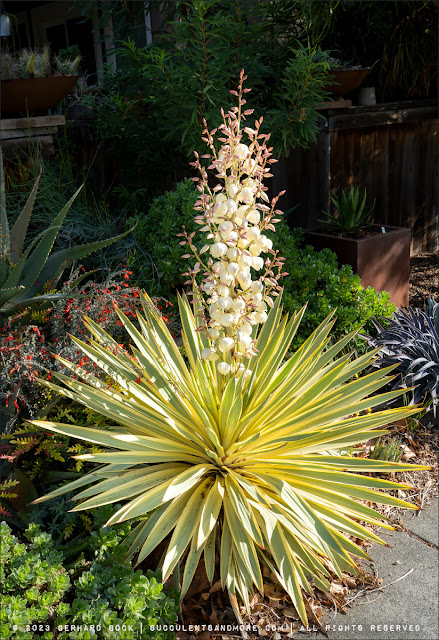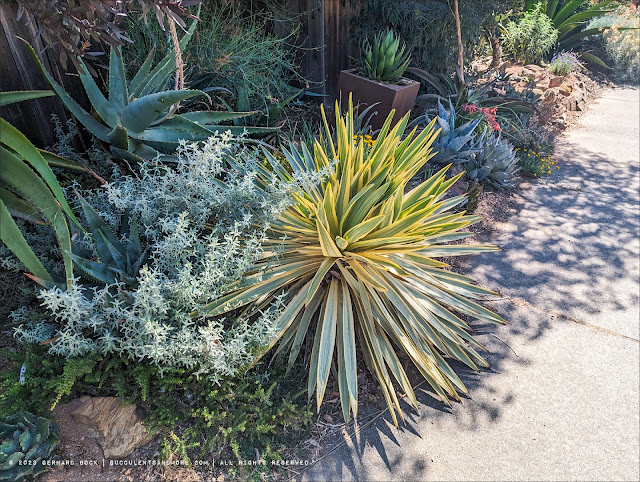Goodbye, Yucca ‘Bright Star’, and hello
Our Yucca ‘Bright Star’ (or, more correctly, Yucca gloriosa var. tristis ‘Bright Star’, formerly known as Yucca recurvifolia) lit up the sidewalk bed for five years before it flowered last November. And the flowers were truly glorious:
Unlike agaves, for which blooming is a terminal event, yuccas are perennial and don’t die after flowering. However, our Yucca ‘Bright Star’ did exactly what I had feared it would do: It started to produce new shoots from the center. Take a look:
Closer:
Over time, what once was a single rosette will become a tangled clump. Many gardeners don’t mind that look, but I much prefer one solitary rosette.
In addition to producing multiple new heads, our ‘Bright Star’ began to sucker from rhizomes––another trait that ruined the symmetry of the rosette.
All these things taken together made a compelling case for removal. Which is exactly what I did. Using a reciprocating saw, I separated the new heads and severed the two suckers. This is the end result: three heads...
For now, I stuck all five pieces in loose soil where they’ll remain until temperatures drop a little. Then I will replant one piece in the same spot where the original ‘Bright Star’ had been (a little further away from the sidewalk so it won’t encroach). The others will go to good homes.
...and two suckers:
The suckers already have some roots, the heads don’t.
Lessons learned: none, really. Other than being prepared for yuccas to multiply after flowering and deciding whether this is acceptable to you or not. You’re the chief executive of your garden; if there’s something you don’t like, you don’t need to live with it.
© Gerhard Bock, 2023. All rights reserved. To receive all new posts by email, please subscribe here.









My Bright Star is doing great even in this heat. I have it in the shade on my patio and I water and keep a close watch on it. I hope mine flowers like yours did some day. I love it!
ReplyDelete'Bright Star' is a trooper. It was in one of the hottest spots in our garden.
Delete"Yuccas are perennial and don't die after flowering." I think you meant yuccas are polycarpic. Agaves, are perennial, but monocarpic. I can't tell from the photo, but yuccas without roots dehydrate quickly, unlike succulents like agaves. I also don't like multiple heads together, yet nurseries often sell three yuccas bunched together in a pot, to give the appearance of a plant with more leaves.
ReplyDeleteYes, polycarpic. Fingers crossed my 'Bright Star' heads will root. If not, at least I have two suckers that have some roots already. I'd love to start from scratch with one of the offsets.
DeleteSome yuccas die after flowering, Yucca filamentosa for example. Although it lives on thru its side-shoots so some folks don't realize that the part that flowered is now dead. I wish that 'Bright Star' liked my climate, such a beautiful plant! Although I don't care for the clumping look with that one either.
ReplyDeleteDidn't know that about Y. filamentosa. I thought all yuccas were polycarpic and Hesperoyucca is monocarpic (which is why it was split off from the genus Yucca). Have you tried 'Bright Star'? It might just make it in Portland.
DeleteNo "head" has ever rooted for me, as Anonymous said they dehydrate quickly. However new rosettes appear from the roots. I would say 'Bright Star' does not age that well. It is one tough plant, though!
ReplyDeleteToo bad about the heads. That's not a good survival strategy, yuccas!!
DeleteI hope all your Yuccas do well. I wasn't a fan of my 'Bright Star' Yuccas appearance after it bloomed (twice) either and, after a gardener "pruned" it, it looked even worse. I cut it to the ground, which prompted 2 offshoots to develop. They're healthy but still relatively small. The head I cut looked fine in its pot for close to a year but it never developed good roots and I gave up on it.
ReplyDeleteI was actually thinking of your experience with 'Bright Star'. I feel that way about Yucca 'Blue Boy', too--it's only good for a few years, then it begins to look a bit unruly.
DeleteEverything has it's moment. I admire your decision to remove it when Bright Star passed it's own moment of perfection. That in itself is a good lesson for a lot of gardeners who hang on to things that really should just be removed or let go. What will take it's place?
ReplyDeleteI thought long and hard about removing 'Bright Star', but our garden is so small, each plant needs to "perform." I really want to plant one of the rooted 'Bright Star' offsets. Fingers crossed at least one will survive.
DeleteI think it looks gorgeous leave it alone
ReplyDelete